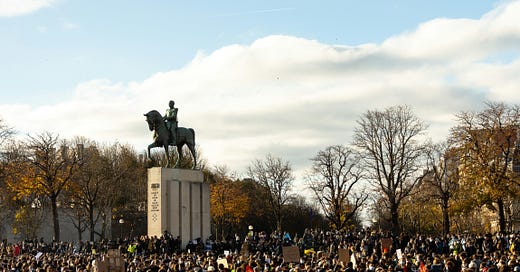The Surprising Effectiveness of Peaceful Protests
Past peaceful efforts to oust a tyrant have been successful
It can happen here too, in 2025.
Photo by Koshu Kunii on Unsplash
Since 2000, eight successful peaceful uprisings have ousted autocratic regimes
Serbia's Bulldozer Revolution (2000): Mass demonstrations resulted in the overthrow of Slobodan Milošević.
Georgia's Rose Revolution (2003): Widespread peaceful protests in Kyiv against disputed elections led to the resignation of President of Eduard Shevardnadze.
Ukraine's Orange Revolution (2004): Peaceful protests against a rigged presidential election resulted in a new election being held.
Lebanese Cedar Revolution (2005): The assassination of former Lebanese P.M. Hariri spurred protests across Lebanon demanding an end to Syria's military presence. Syrian troop withdrawal was followed by resignation of the pro-Syrian government.
Tunisia's Arab Spring (2011): Protests against unemployment and corruption led to the successful ousting of President Zine El Abidine Ben Ali and Tunisia's transition to democracy.
Egyptian Revolution (2011): Along with extensive strikes and sit-ins, hundreds of thousands of Egyptians occupied Tahrir Square and forced dictator Hosni Mubarak from power.
Armenia's Velvet Revolution (2018): A movement against the ruling party led to a peaceful transfer of power.
Sudan (2019): Peaceful demonstrations and sit-ins against the military-backed regime led to the overthrow of Omar al-Bashir and a transition to civilian rule.
The late 1980’s saw peaceful uprisings in four additional countries
The Singing Revolution in Estonia, Latvia, and Lithuania (1987-1991) led to restoration of independence in three Soviet-occupied Baltic countries.
Philippines' People Power Revolution (1986): A large-scale, nonviolent, sustained campaign of civil resistance against regime violence and electoral fraud led to the removal of dictator Ferdinand Marcos.
About sources for the following sections:
The information below is taken from several sources: Maria J. Stephan and Erica Chenoweth’s Why Civil Resistance Works: The Strategic Logic of Nonviolent Conflict study analyzes findings from 100+ scholarly articles. In his 2019 BIG THINK article, Charles Euchner gleaned pertinent facts from the above findings in his article To overthrow a tyrant, try the 3.5 Percent Solution. Gene Sharp’s The Politics of Nonviolent Action is the fourth source. I’ve rearranged information segments from all four in order to convey my points. Some I’ve copied verbatim, other parts are citations by Euchner of material In Stephan & Chenoweth’s work. This paragraph includes hyperlinks to all four sources.
The Impetus for Civil Resistance: When Enough People Refuse to Obey the Regime’s Orders
Note: This topic will be expanded in a future article that will delve into the subject so eloquently described by Timothy Snyder’s Lesson 1: Do not obey in advance.
{Sharp} Regimes gain power when ordinary citizens consent to their rule. Usually, that consent is tacit, when people pay taxes, accept government regulations, and follow basic practices like sending kids to school; sometimes, it’s explicit, like adhering to court decisions and voting in elections. Nonviolent demonstrations, in effect, withdraw that consent. And no regime can survive when too many people refuse to obey the regime’s orders.
Why Civil Resistance Works: The Strategic Logic of Nonviolent Conflict
{Stephan & Chenoweth} For more than a century, from 1900 to 2006, campaigns of nonviolent resistance were more than twice as effective as their violent counterparts in achieving their stated goals. By attracting impressive support from citizens, whose activism takes the form of protests, boycotts, civil disobedience, and other forms of nonviolent noncooperation, these efforts help separate regimes from their main sources of power and produce remarkable results.
{Euchner citing Stephan & Chenoweth} Such mass demonstrations are so visible that no one can ignore them. Their diversity and networks—with connections to schools, unions, churches, media, sports teams, fraternities, and even the military—gives them a superhuman voice and spirit. At that scale, most soldiers have no desire to suppress the protesters. Why? Because the crowd includes their family members, friends, coworkers, and neighbors.
To Overthrow a Tyrant, Just 3.5% of American Patriots Need to (Peacefully) Speak Up, Stand Up, & Show Up
{Charles Euchner} identifies these key takeaways:
No democracy movement has ever failed when it was able to mobilize at least 3.5 percent of the population to protest over a sustained period.
With a population of 327 million, the U.S. would need to mobilize about 11.5 million people to assert popular, democratic power on the government.






My take is that there has to be more than mobilization, there has to be organization of new systems within a society. We must challenge the business-as-usual of the two party system, which fails to serve the 99%. Or the tyrants take over again (Egypt), or your country plunges into civil war (Sudan).